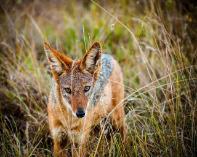Global Efforts Drive Investment and Policy Change in Rabies Post-Exposure Prophylaxis
Published: 16 November 2023
SBOHVM has emerged as a leader in the quest to eliminate canine rabies, conducting groundbreaking research to understand transmission dynamics and develop control measures.
Global Efforts Drive Investment and Policy Change in Rabies Post-Exposure Prophylaxis
 Rabies remains a deadly global threat, claiming approximately 59,000 human lives each year and causing substantial economic losses. Access to lifesaving rabies post-exposure prophylaxis (PEP) varies widely, hindering effective treatment. However, a collaborative effort involving SBOHVM researchers and international organisations is reshaping the landscape of rabies control.
Rabies remains a deadly global threat, claiming approximately 59,000 human lives each year and causing substantial economic losses. Access to lifesaving rabies post-exposure prophylaxis (PEP) varies widely, hindering effective treatment. However, a collaborative effort involving SBOHVM researchers and international organisations is reshaping the landscape of rabies control.
Global Burden
Canine rabies, primarily transmitted by domestic dogs, accounts for over 99% of rabies-related human deaths. Annually, it results in 3.7 million disability-adjusted life years and costs the global economy USD 8.6 billion.
Underpinning Research
SBOHVM has emerged as a leader in the quest to eliminate canine rabies, conducting groundbreaking research to understand transmission dynamics and develop control measures.
Rabies Post-Exposure Prophylaxis (PEP)
PEP is crucial for those bitten by suspect dogs in regions where rabies is prevalent. Multiple PEP regimens exist, but their inconsistent use and a lack of clear recommendations have posed challenges. In 2010, SBOHVM researchers introduced a cost-effectiveness framework, highlighting the superiority of intradermal (ID) delivery, which has the potential to save more lives.
Vaccination Programs
In parallel, researchers explored the impact of significant PEP investment by "Gavi, the Vaccine Alliance." Their work across 18 countries demonstrated that ID vaccination is feasible even in resource-poor settings, reducing vaccine use by 50% while improving health outcomes.
Impact on Policy and Investment
SBOHVM's research provided vital data that influenced international policy and investment strategies. This research laid the foundation for WHO's updated consensus position statement on rabies PEP, aligning recommendations with real-world usage. In 2018, Gavi, the Vaccine Alliance, included rabies PEP in its 2021–2025 investment strategy, endorsing shorter and cost-effective regimens.
Gavi's Investment in Rabies PEP
Gavi's decision to invest in rabies PEP for the 2021–2025 period was based on validated PEP regimens and impact modelling. This move opens the door to support for rabies PEP across 57 eligible countries, potentially preventing 489,000 rabies-related deaths.
Secondary Impacts on National Policies
The WHO's position on rabies PEP has already prompted several countries, including the Philippines, Nepal, and Bhutan, to revise their guidelines. Others, such as Bangladesh, Côte d'Ivoire, Madagascar, Cambodia, and regions in India, Pakistan, and Tanzania, are following suit, aligning their policies with global recommendations.
Efforts to combat rabies continue to evolve, driven by collaborative research and investments that aim to save lives and reduce the global burden of this deadly disease.
First published: 16 November 2023

